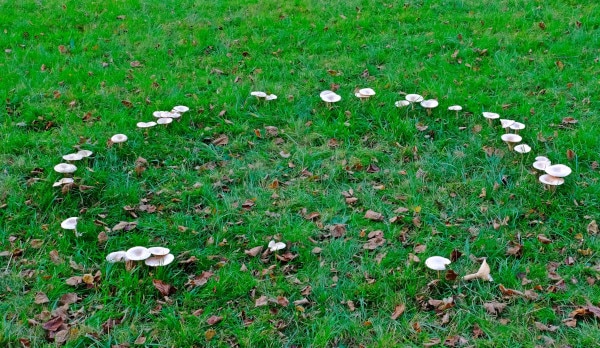Home / Information & advice / Turf & Lawns / Lawn diseases / Fairy rings
Fairy rings are a group of diseases in turf grass that are caused by fungi. There are thousands of fungi that can cause fairy rings.
The most common type of fairy ring can be recognised in turf, because it causes the turf to grow dark green, in a ring or arc. These measure about 75-200mm wide as an arc, and up to a metre in diameter as a ring.
Keep reading for further information about fairy rings and how to treat them in your lawn
If you answer yes to any of the above questions, you could have fairy rings in your turf.
Fairy rings can be many years old, and will grow as long as there is turf for them to grow in. There are other types of fairy rings that cause the grass to turn yellow, others that can cause a patch of stunted, reddish turf, and still others that can cause the grass to wilt and die. You may notice that fairy rings do not grow together when they meet in a lawn. This is how arcs or pieces of fairy rings are formed.

Fairy rings begin when a fungus starts growing in your turf. What causes a fungus to start growing in turf is not clear to scientists, but often grass that has a thatch layer and is growing on natural soils that receive ample moisture, will develop fairy rings. Fairy rings will grow in finely manicured turfs, sports turfs, golf greens, and unmown swards. In general, they grow at a rate of about 75-150mm per year.
Yes, sometimes if you take a pocket knife and cut across the fairy ring, you will see white threads growing in the thatch. The white threads are mycelium of the fairy ring fungi.
Fairy ring fungi are beneficial fungi that attack and breakdown dead and decaying plant material. Thatch is a mat of dead plant material, and the fairy ring fungi can live and grow in it. As they do, they cause the dead plant material to decay. The decaying material is used by many different micro-organisms that live in the soil. When this happens, nitrogen and other nutrients important for turf growth are made available to the plant. Hence, the plant is able to use these nutrients to grow taller and darker.
Generally not, and if they do, they do not kill the grass. However, after the fairy ring fungi have colonised the thatch layer, and it starts to dry out, a problem arises for the turf. Turf and thatch that have fairy ring fungi colonising them resist being watered, much like a sponge after it has dried out. Thus, when turf colonised by a fairy ring dries out, it resists being watered. Therefore, this grass often does not get enough water. As a result, this grass suffers from drought, even though the grass outside and inside of the fairy ring grows well. If the drought lasts too long, this grass will be stunted, wilt and could then die.
There are several things that you can do to avoid or reduce the appearance of fairy rings.
To reduce the potential of fairy rings occurring:
If you have a fairy ring in your turf:
Yes, there are fungicides approved for use to control fairy rings, but their effectiveness may be inconsistent. If you are considering the use of fungicides to treat fairy rings, consult a turf expert. We also recommend that you obtain advice about chemical and non-chemical grass treatment products directly from the manufacturers
Yes, but it is difficult. You would need to dig out and replace, to a depth of about 300mm, all of the soil within the fairy ring and about 300mm outside of the ring. This is not recommended.
Fairy rings are caused by fungi that live in most soils, and they decompose dead plant material. Generally, they do not attack living turf, and the best method to control them is through masking their appearance with fertiliser.
Further lawn care advice can be found in our Information Centre. You can also sign up for lawn tips to receive regular lawn care advice, news and promotional offers by email which will help you get the best from your lawn.
For more techniques to help you maintain a healthy lawn, explore our other lawn aftercare advice.
You can also sign up to our newsletter to receive free seasonal lawn care advice and reminders of essential maintenance, as well as general horticultural advice and special offers from Rolawn.